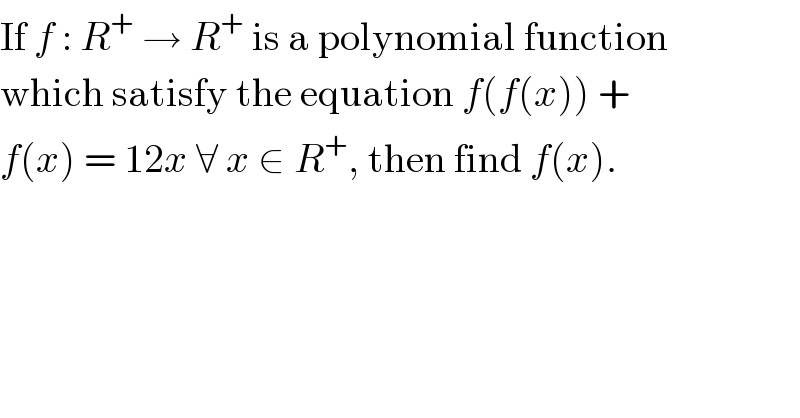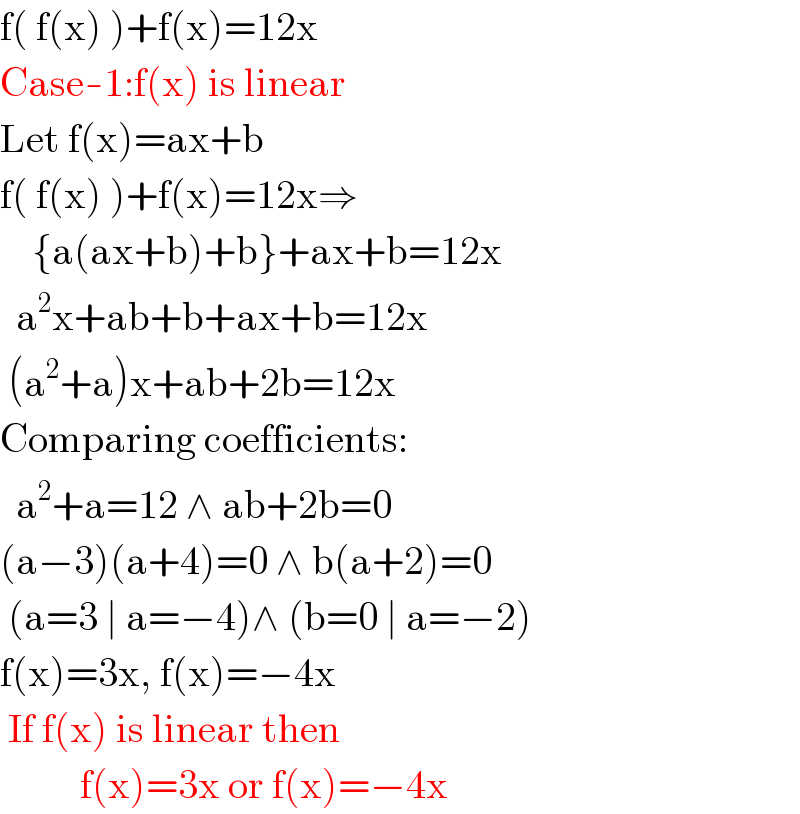
Question Number 22133 by Tinkutara last updated on 11/Oct/17

$$\mathrm{If}\:{f}\::\:{R}^{+} \:\rightarrow\:{R}^{+} \:\mathrm{is}\:\mathrm{a}\:\mathrm{polynomial}\:\mathrm{function} \\ $$$$\mathrm{which}\:\mathrm{satisfy}\:\mathrm{the}\:\mathrm{equation}\:{f}\left({f}\left({x}\right)\right)\:+ \\ $$$${f}\left({x}\right)\:=\:\mathrm{12}{x}\:\forall\:{x}\:\in\:{R}^{+} ,\:\mathrm{then}\:\mathrm{find}\:{f}\left({x}\right). \\ $$
Commented by Rasheed.Sindhi last updated on 22/Oct/17

$$\mathrm{f}\left(\:\mathrm{f}\left(\mathrm{x}\right)\:\right)+\mathrm{f}\left(\mathrm{x}\right)=\mathrm{12x} \\ $$$$\mathrm{Case}-\mathrm{1}:\mathrm{f}\left(\mathrm{x}\right)\:\mathrm{is}\:\mathrm{linear} \\ $$$$\mathrm{Let}\:\mathrm{f}\left(\mathrm{x}\right)=\mathrm{ax}+\mathrm{b}\: \\ $$$$\mathrm{f}\left(\:\mathrm{f}\left(\mathrm{x}\right)\:\right)+\mathrm{f}\left(\mathrm{x}\right)=\mathrm{12x}\Rightarrow \\ $$$$\:\:\:\:\left\{\mathrm{a}\left(\mathrm{ax}+\mathrm{b}\right)+\mathrm{b}\right\}+\mathrm{ax}+\mathrm{b}=\mathrm{12x} \\ $$$$\:\:\mathrm{a}^{\mathrm{2}} \mathrm{x}+\mathrm{ab}+\mathrm{b}+\mathrm{ax}+\mathrm{b}=\mathrm{12x} \\ $$$$\:\left(\mathrm{a}^{\mathrm{2}} +\mathrm{a}\right)\mathrm{x}+\mathrm{ab}+\mathrm{2b}=\mathrm{12x} \\ $$$$\mathrm{Comparing}\:\mathrm{coefficients}: \\ $$$$\:\:\mathrm{a}^{\mathrm{2}} +\mathrm{a}=\mathrm{12}\:\wedge\:\mathrm{ab}+\mathrm{2b}=\mathrm{0} \\ $$$$\left(\mathrm{a}−\mathrm{3}\right)\left(\mathrm{a}+\mathrm{4}\right)=\mathrm{0}\:\wedge\:\mathrm{b}\left(\mathrm{a}+\mathrm{2}\right)=\mathrm{0} \\ $$$$\:\left(\mathrm{a}=\mathrm{3}\:\mid\:\mathrm{a}=−\mathrm{4}\right)\wedge\:\left(\mathrm{b}=\mathrm{0}\:\mid\:\mathrm{a}=−\mathrm{2}\right) \\ $$$$\mathrm{f}\left(\mathrm{x}\right)=\mathrm{3x},\:\mathrm{f}\left(\mathrm{x}\right)=−\mathrm{4x} \\ $$$$\:\mathrm{If}\:\mathrm{f}\left(\mathrm{x}\right)\:\mathrm{is}\:\mathrm{linear}\:\mathrm{then}\: \\ $$$$\:\:\:\:\:\:\:\:\:\:\mathrm{f}\left(\mathrm{x}\right)=\mathrm{3x}\:\mathrm{or}\:\mathrm{f}\left(\mathrm{x}\right)=−\mathrm{4x} \\ $$
Answered by ajfour last updated on 14/Oct/17
![let f(x)=y As f(y)+f(x)=12x ⇒ (df/dy)×f ′(x)+f ′(x)=12 or ((df/dy)+1)f ′(x)=12 ⇒(df/dy)=constant & f ′(x)=constant let f ′(x)=a , then (df/dy)=((12)/a)−1 ..(i) ⇒ f ′(x)=ax+b (..say) f(y)=ay+b and (df/dy)=a ...(ii) from (i) and (ii): a=((12)/a)−1 ⇒ a^2 +a−12=0 ⇒ a=−4 , 3 now f(y)+f(x)=12x ⇒ (ay+b)+(ax+b)=12x ⇒ [a(ax+b)+b]+ax+b=12x or (a^2 +a)x+b(a+2)=12x ⇒ a^2 +a=12 and b(a+2)=0 So a=−4 , 3 while b=0 Hence f(x)=−4x or f(x)=3x .](Q22259.png)
$${let}\:{f}\left({x}\right)={y} \\ $$$${As}\:\:\:{f}\left({y}\right)+{f}\left({x}\right)=\mathrm{12}{x} \\ $$$$\Rightarrow\:\:\:\:\:\frac{{df}}{{dy}}×{f}\:'\left({x}\right)+{f}\:'\left({x}\right)=\mathrm{12} \\ $$$${or}\:\:\:\left(\frac{{df}}{{dy}}+\mathrm{1}\right){f}\:'\left({x}\right)=\mathrm{12} \\ $$$$\Rightarrow\frac{{df}}{{dy}}={constant}\:\&\:{f}\:'\left({x}\right)={constant} \\ $$$${let}\:{f}\:'\left({x}\right)={a}\:\:\:\:,\:{then}\:\frac{{df}}{{dy}}=\frac{\mathrm{12}}{{a}}−\mathrm{1}\:..\left({i}\right) \\ $$$$\Rightarrow\:\:{f}\:'\left({x}\right)={ax}+{b}\:\:\:\:\:\:\left(..{say}\right) \\ $$$$\:\:\:\:\:\:\:{f}\left({y}\right)={ay}+{b} \\ $$$${and}\:\:\:\:\frac{{df}}{{dy}}={a}\:\:\:...\left({ii}\right) \\ $$$${from}\:\left({i}\right)\:{and}\:\left({ii}\right): \\ $$$$\:\:\:\boldsymbol{{a}}=\frac{\mathrm{12}}{\boldsymbol{{a}}}−\mathrm{1}\:\:\:\:\Rightarrow\:\:{a}^{\mathrm{2}} +{a}−\mathrm{12}=\mathrm{0} \\ $$$$\Rightarrow\:\:\:\:\:\:{a}=−\mathrm{4}\:,\:\mathrm{3} \\ $$$${now}\:\:\:{f}\left({y}\right)+{f}\left({x}\right)=\mathrm{12}{x} \\ $$$$\Rightarrow\:\:\:\:\:\left({ay}+{b}\right)+\left({ax}+{b}\right)=\mathrm{12}{x} \\ $$$$\Rightarrow\:\:\:\:\:\:\left[{a}\left({ax}+{b}\right)+{b}\right]+{ax}+{b}=\mathrm{12}{x} \\ $$$${or}\:\:\:\:\:\:\:\left({a}^{\mathrm{2}} +{a}\right){x}+{b}\left({a}+\mathrm{2}\right)=\mathrm{12}{x} \\ $$$$\Rightarrow\:\:\:\:{a}^{\mathrm{2}} +{a}=\mathrm{12}\:\:\:{and}\:\:\:{b}\left({a}+\mathrm{2}\right)=\mathrm{0} \\ $$$$\boldsymbol{{S}}{o}\:\:\:\:\boldsymbol{{a}}=−\mathrm{4}\:,\:\mathrm{3}\:\:\:\:\:{while}\:\boldsymbol{{b}}=\mathrm{0} \\ $$$$\:\:\:\:\:\boldsymbol{{Hence}}\:\:\:\boldsymbol{{f}}\left(\boldsymbol{{x}}\right)=−\mathrm{4}\boldsymbol{{x}}\: \\ $$$$\:\:\:\:\:\:\:\:\:\:\:\:\:\:\:\:\:\boldsymbol{{or}}\:\:\:\:\boldsymbol{{f}}\left(\boldsymbol{{x}}\right)=\mathrm{3}\boldsymbol{{x}}\:. \\ $$
Commented by Tinkutara last updated on 14/Oct/17

$$\mathrm{Thank}\:\mathrm{you}\:\mathrm{very}\:\mathrm{much}\:\mathrm{Sir}! \\ $$
